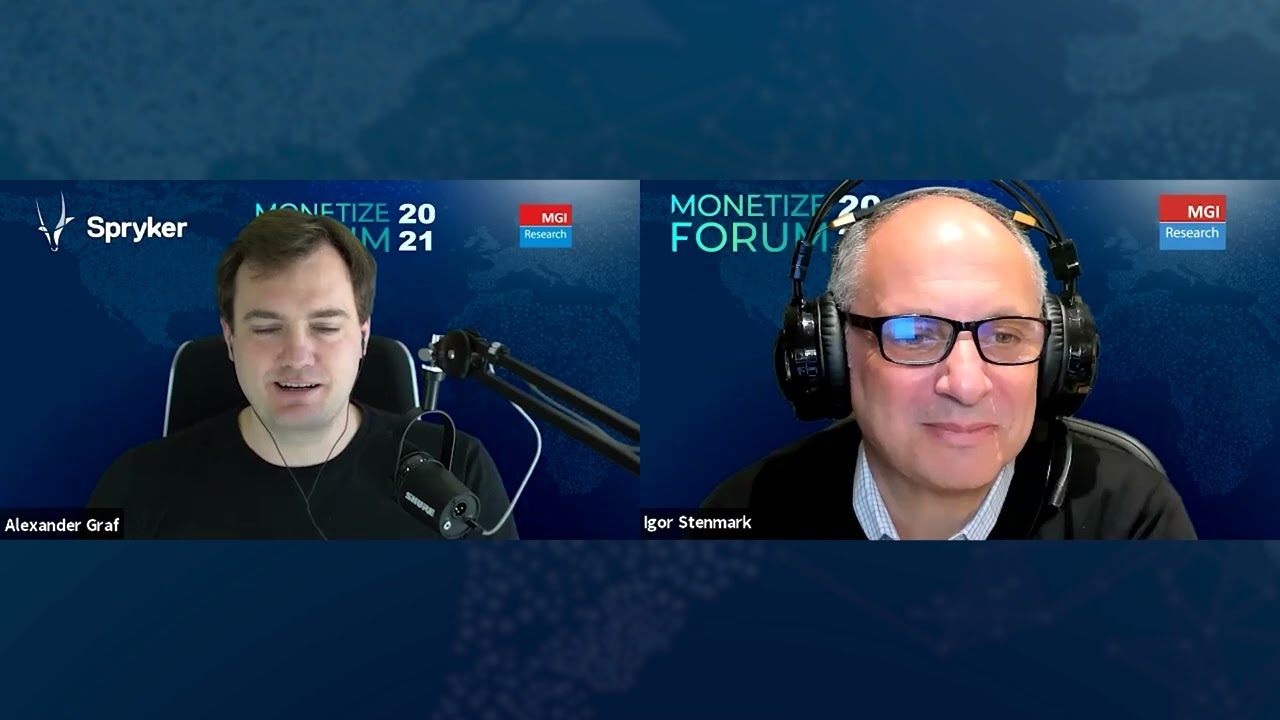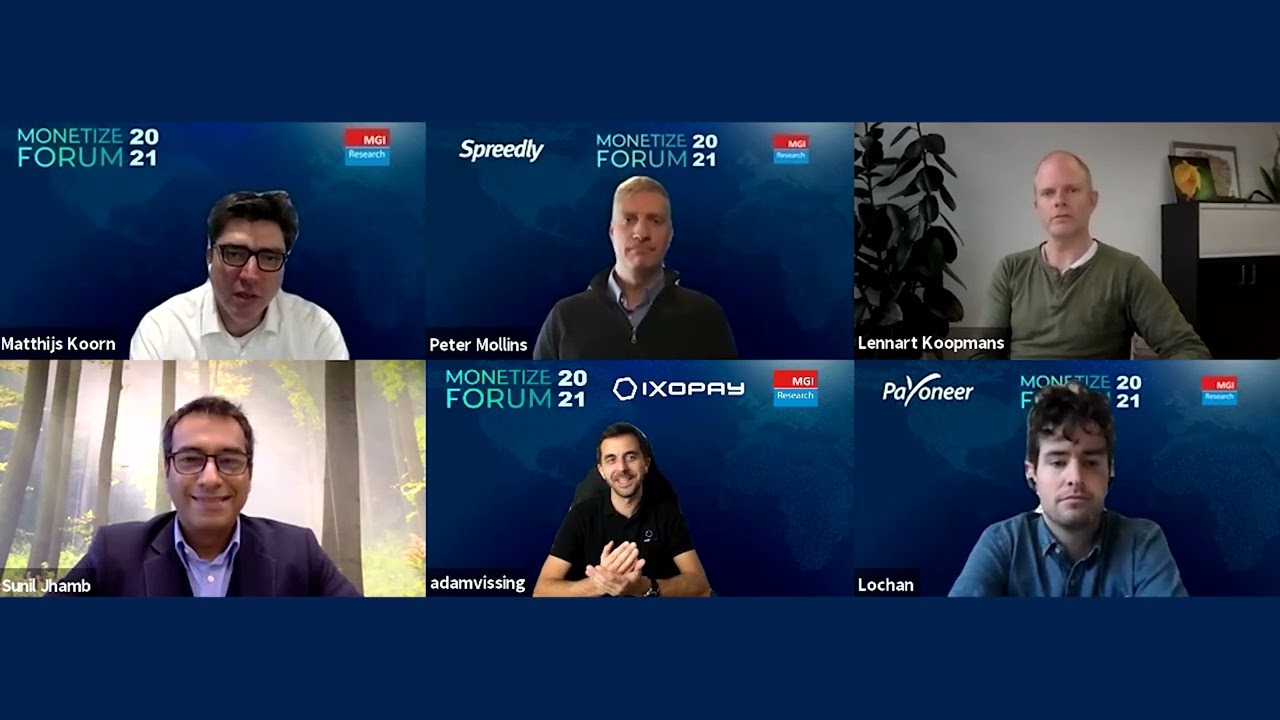There’s a lot of focus (and rightly so) on online security and keeping out the users that shouldn’t be accessing your website. However, fewer companies take the same initiative when it comes to understanding and nourishing their relationships with the users they do want—mainly, because they have no idea who the truly interested ones are. Bread & Butter is a young company with the mission of helping businesses convert users sooner and track their online journeys to improve overall experience, reach out with more precise marketing, and better identify their real leads. To learn more, we invited the company’s CTO and Co-Founder Matt McLean to speak with MGI Research analyst Andrew Dailey at the 2021 Monetize Forum.
Key Issues
What is Bread & Butter, and what pain points were its creators looking to solve for?
What is the use case for the Bread & Butter product?
How can converting users sooner work for both business and customer?
Guest Profile
Matt is the CTO and Co-Founder of Bread & Butter, a company that enables businesses to key into their customers’ online journey. This process allows them to identify points of friction and engagement, customize marketing, and secure more valuable leads. Prior to Bread & Butter, Matt was deeply involved in two other software firms, both of which achieved successful financial exits.
Andrew Dailey
Hi, everyone. I’m Andrew Dailey of MGI Research, and welcome to our session, “Surfing to Commerce: Knowing Your Customer.” When we put this conference together each year, in addition to focusing on frictionless monetization, we always try to filter for really interesting companies to bring to the event, companies that have created something with a potentially very broad appeal to our audience and even beyond. To make it into the Monetize Forum, companies really need to solve a real-world problem that affects a lot of companies and a lot of consumers, with an aim to make the world a more interesting and frictionless place through conceptually changing old, established processes. We also like to find companies with an interesting backstory because we think they ultimately end up being some of the long-term winners.
So, join me in welcoming our next guest speaker, Matt McLean, the CTO and Co-Founder of Bread & Butter. Matt is on his third company, having previously been a key member of two other software firms, both of which delivered really interesting innovation before resulting in very successful financial exits. His new venture, Bread & Butter, is a bit of a departure from the last one. Bread & Butter automates a necessity that every one of us deals with on a daily basis. With that as a background, Matt, welcome to the Monetize Forum.
Matt McLean
Thank you, Andrew. I’m happy to be here.
Andrew Dailey
To start, what is Bread & Butter?
Matt McLean
At its core, Bread & Butter is a set of tools we’ve designed to help internet executives really focus on their most important asset: their online users. We do this by helping them make sense of what we call their user journey. Along this journey, we help them really track what users do and how they’re interacting with the website and app, from a user’s first anonymous visit to a site on all their different devices all the way to the moment they become a known, verified user and what we call “sales-ready.” Then, for as long as they interact with the website after that, we continue recording this information.
Within this user journey, the most important goal is really for you to find out who your user is and to get them to that known, verified, sales-ready state as quickly as you can—critical to that goal is doing this before they have a chance to have second thoughts, get distracted, or ultimately leave your website. For example, think of the number of times you’ve been to a website, hit the point of registration, and then decided it wasn’t worth the effort at the time? Alternately, maybe you’re in the middle of a purchase with a half-filled cart, and you get distracted and leave it. That probably happens a lot, right?
Andrew Dailey
Yes, it happens all the time, and I may or may not come back; presumably, the sites have no idea because I haven’t registered with them. They have no idea who I am and no ability to reach back out to me to re-engage personally.
Matt McLean
Additionally, when you leave, you as a user are missing out on valuable information because you came for a reason. Maybe you’re missing out on that purchase you wanted but didn’t prioritize at the time. Maybe you were distracted, or maybe it was more complex. Maybe you didn’t want to create another login with a complex password that you would probably forget at some point, necessitating that reset process over and over and over. We all have our own priorities, and sometimes, a step just ends up not being worth your time, but, ultimately, the business whose website you just abandoned has lost you as a lead. How expensive was it to get you to their website? Were they using Google Ads or some kind of marketing material? Basically, they’ve just thrown that away.
So really, solving for that became our primary focus: How can we help you convert your users sooner? How can we remove the friction in this process? How can we help you not have users leaving your website without you being able to follow up with them? We’ve solved these problems by allowing your users to authenticate with the established channels they’re comfortable and familiar with. If, instead of requiring a lengthy signup, you allow your users to authenticate with Facebook or Google (or even Okta for corporate users), it really removes the barrier of your users deciding, “Okay, should I do this or not? Is this worth the trouble of creating another account?” It’s important to make sure that this is in front of your user as early as possible within the user journey, and the process needs to be simple. It should almost be a reflex—we like to say, “One click, and you’re in.”
Additionally, we’ve put a lot into helping you build out a reward system to really make your users want to convert sooner. So, before they get that white paper or even use your “contact us” form, you ask that they first quickly establish who they are. Another example is not requiring your users to wait until checkout to apply a coupon. If they can apply it immediately by performing a one-click signup while still shopping, you keep them engaged. They have this interaction live, and you’re actually getting information upfront as well. On top of that, once we have this process in place to get to really know your users, we’re able to help you build a profile on how they have interacted with your website. Using that information, we help you really personalize your visitor experience and how you end up marketing to users further in their user journey.
Andrew Dailey
What’s the backstory to Bread & Butter? What led to you trying to solve this problem?
Matt McLean
Most of our team has been together for almost 20 years. Bread & Butter is our third internet venture, and we really created it out of necessity. For as long as we can remember, our team has always excelled in solving technology problems, and the difficult part of the business became figuring out the marketing side and really determining which customers to focus our efforts on.
Our last venture was a secure email product called DeliverySlip, and it was actually acquired by our main competitor, a publicly traded company called Zix Corp. While we were developing DeliverySlip and other previous products, we were trying to solve this problem and ended up reviewing a number of different products to help us figure out things like our customer acquisition cost, our average revenue per customer, and the longevity of our most valuable customers. Over the years, we probably looked through two dozen different complex tools to solve these problems, and they were all very feature-rich. There are a lot of great tools out there, but they always came at a price. Of course, there’s the licensing price, but, more importantly and often more hidden, the implementation and learning curve for all these different products is what’s really prohibitive for a smaller company. We didn’t have time to become experts in everything, so we often saw the only option was to just target a few of these different products to really focus on an angle of the problem or to create disjointed custom solutions that could get us to a good enough place to get started.
We found this to be a common issue, and that’s really where the idea was born—to create a cloud product that would overlap maybe half a dozen of these different products and really focus on providing 30% of the high-value features, at 30% of the price, and, more importantly, in 30% of the implementation time. As an internet executive myself, I know we all end up with the same goal: we want to increase our average revenue per user (ARPU), and we want to decrease our customer acquisition cost (CAC). While we don’t have the magic formula for this, we built Bread & Butter to help you convert your users sooner, give you more visibility into that data, and then allow you to take action on what you target as your high-value users. And again, we’re trying to do this in a way that doesn’t break the bank and is simple, so your team’s not spending months configuring an excess of different third-party products to help you achieve this. We joke that we don’t want our customers to feel like they need a PhD in Bread & Butter to really understand how to use the product effectively.
Andrew Dailey
If I don’t need a PhD to use the product, who is the typical customer?
Matt McLean
Typical customers for us are digital agencies, ISVs, and systems integrators. Anybody with a website or app can really make use of our product, but we decided to focus on what I call the “one-too-many” applications. It’s more profitable for us to target a digital agency that has hundreds of potential Bread & Butter customers than to target each company individually. This helps us offer a really rich feature set at a lower price point, and we’ve therefore made our analytics dashboard really sticky for the digital agencies and ISVs. We’ve really tried to make it simple to customize and segment your users and summarize your data individually for all the different customers that you have, all in one easy-to-use dashboard. Our goal is to really take care of what we find is overlooked and help you focus on your bread and butter.
Andrew Dailey
That makes sense. In terms of the most common use cases, is that e-commerce? Is it B2C or B2B?
Matt McLean
Yes, you nailed it. In general, one of the biggest-impact use cases for us is e-commerce. We’ve created one-click plugins for WordPress, WooCommerce, and Shopify, and basically, our goal is to help executives get more visibility into the lifecycle of their online customer (through that user journey) without going through a big process. As we talked about before regarding e-commerce, why wait for your formal cart checkout to know who your user is? Our tools help you focus on converting your users earlier in that process to avoid only finding out who they are at that last stage.
Andrew Dailey
Right. Even in the B2B context, all the data that we and others have shows that people are doing all their information gathering online. They’re collecting data and are engaged in an evaluation process, but if they haven’t registered with your site, you don’t know that they’re looking or even who they are. As a result, your account execs or channel partners don’t know who to reach out to. So, I can see the place for it in both the B2C and B2B context.
Matt McLean
Yes, and you’re basically just crossing your fingers and hoping they’re going to re-engage. You’re leaving it up to the user.
Andrew Dailey
You guys have obviously thought about this a lot. Is there a point at which you say, “We don’t want to become a marketing platform. We don’t want to get into the commerce space directly”? Where does Bread & Butter stop and the full bakery, so to speak, start?
Matt McLean
Yes, I’m sure there are plenty of apt bread and butter-related puns for the situation. Really though, our focus is always on your users’ online user journey. While we help you track that journey, we are not a CRM. We integrate with most of the popular CRMs (Salesforce and Marketo, for example), but our goal is to pass more reliable user information to that CRM—again, identifying the sales-ready users.
I say “reliable” because, in helping you allow your users to sign in with the credential they already trust, you’re also creating user data that you can put more trust into. You’re not allowing them to just enter an email while you hope they are who they claim to be. They’re going through a big tech channel that they’ve had to invest in. For example, with B2C, they may be using Google or Facebook, and with B2B applications, they may use more secure enterprise solutions like Okta or Office 365. When you allow your user to sign up and login through a trusted channel rather than by creating a new account (with yet another password to manage and whatever other friction or barriers go into that process), that really helps both parties.
Andrew Dailey
Yes, absolutely. It creates more credibility for your own brand when your prospects and customers can access it through a trusted process. So, what should everyone remember about Bread & Butter other than the great name?
Matt McLean
Our product is based on 20 years of experience in this space, and one of the important things to know is that we built it in a way that doesn’t require you to replace what you’re already using. That might sound simple, but it was very difficult to achieve. We like to say we’ve built our system to be non-egocentric in its implementation because it was important to us that Bread & Butter play nice with others. For example, under that mantra, we integrate with Google Analytics and allow you to export these sales-ready profiles to Mailchimp or Marketo. Our goal is not to replace the tools that are important to you, that you’ve already invested in. We want to build a solution that works on top of your existing system. Additionally, our implementation is really simple. Honestly, you can be up and running within the same day without any major changes to how your product was working. We feel like the benefits from our products pay for themselves immediately by handling the process of knowing your users and getting them into your system. I’ve been saying it a lot, but again, we’re really giving you the ability to focus on your bread and butter.
Andrew Dailey
I like that term, “non-egocentric.” That perspective is exactly what I talked about in the opening keynote as well, so it obviously fits with our worldview. Matt, we are out of time, but I want to thank you and thank everyone out there listening. Matt will be around at the Bread & Butter booth if anybody wants to reach out, and I would encourage everyone to do so. With that, thanks again, and enjoy the rest of the Monetize Forum.
Matt McLean
Thank you.





